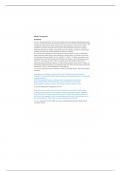Aortic Aneurysm
Scenario
A.H. is a 70-year-old retired construction worker who has experienced lumbosacral pain,
nausea, and upset stomach for the past 6 months. He has a history of heart failure, high
cholesterol, hypertension (HTN), sleep apnea, and depression. His chronic medical
problems have been managed over the years with benazepril (Lotensin) 5 mg/day,
fluoxetine (Prozac) 40 mg/day, furosemide (Lasix) 20 mg/day, potassium chloride (KCl)
20 mEq (20 mmol) bid, and atorvastatin 40 mg each evening.
A.H. has just been admitted to the hospital for surgical repair of a 6.2-cm abdominal
aortic aneurysm (AAA) that is now causing him constant pain. On arrival to your floor,
his vital signs (VS) are 109/81, 61, 16, and 98.3 ° F (36.8 ° C). When you perform your
assessment, you find that his apical heart rhythm is regular, and his peripheral pulses
are all 2+. His lungs are clear, and he is awake, alert, and oriented. There are no
abnormal physical findings; however, he has not had a bowel movement for 3 days. His
electrolytes, blood chemistries, and clotting studies are within normal range, except his
hematocrit is 30.1%, and hemoglobin is 9 g/dL (90 g/L).
1. A.H. has several common risk factors for AAA in his health history. Name and explain
3 factors.
Hyperlipidemia, leading to atherosclerosis: This is inferred because he is taking
lovastatin, a drug used to reduce serum lipid levels. Atherosclerosis injures vessel walls,
causing weakness.
HTN: The elevated BP puts a continuous strain on weakened arterial walls.
Advanced age: HTN and atherosclerosis are more common in the elderly.
Male gender: For unknown reasons, the incidence of AAA is higher in men.
2. How is testing used to diagnose an AAA?
Tests find out the location, size, and rate of growth of an aneurysm. These include
an abdominal ultrasound; CT and magnetic resonance angiogram (MRA), especially
when information is needed about the aneurysm's location and the blood vessels of
the kidney; and angiogram, which can help determine the size of the aneurysm and if
there are dissections, blood clots, or other blood vessel involvement.
3. A.H.’s aneurysm has the shape as in the accompanying illustration. What type of
aneurysm is this?
, a. Aortic dissection
b. False aortic aneurysm
c. Saccular aortic aneurysm
d. Fusiform aortic aneurysm
Correct answer: d
This is a fusiform aortic aneurysm.
CASE STUDY PROGRESS
While A.H. awaits his surgery, it is important that you monitor him carefully for
decreased tissue perfusion.
4. Name 5 things you would assess for, stating your rationale for each.
Urinary output: A decrease in kidney perfusion will result in decreased urine production
Abdominal or lumbosacral pain: An increase in pain can mean enlargement or leakage
of the aneurysm
Bowel sounds: Decreased or absent bowel sounds can mean decreased perfusion of the
GI tract
Peripheral circulation: Decrease in pedal pulses, coolness, cyanosis, or mottling of the
skin of the feet, or increase in capillary refill time, indicates impaired peripheral
circulation
Chest pain: If perfusion of the myocardium is decreased, the heart can become ischemic
VS: Hypotension, tachycardia, and tachypnea are signs of hypovolemic shock
LOC: He may become confused and anxious if cerebral perfusion is diminished
5. What is the most serious, life-threatening complication of AAA and why?
Rupture of the aneurysm with subsequent hemorrhage as it can be rapidly fatal
6. What single problem mentioned at the beginning of this case study is a risk for this
complication? Why?




